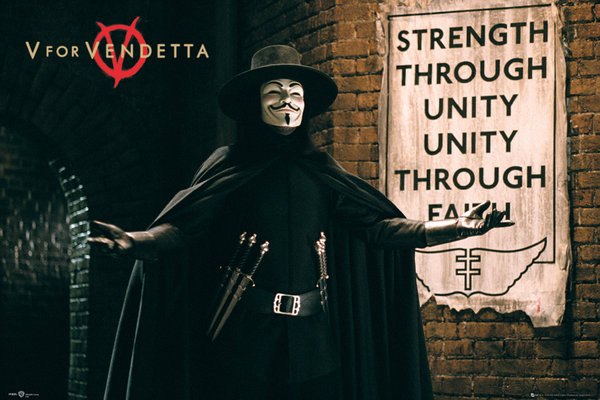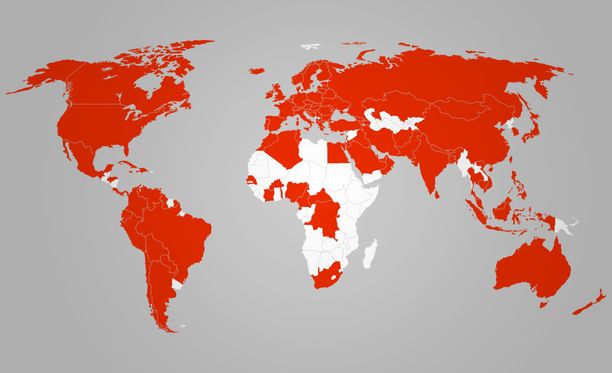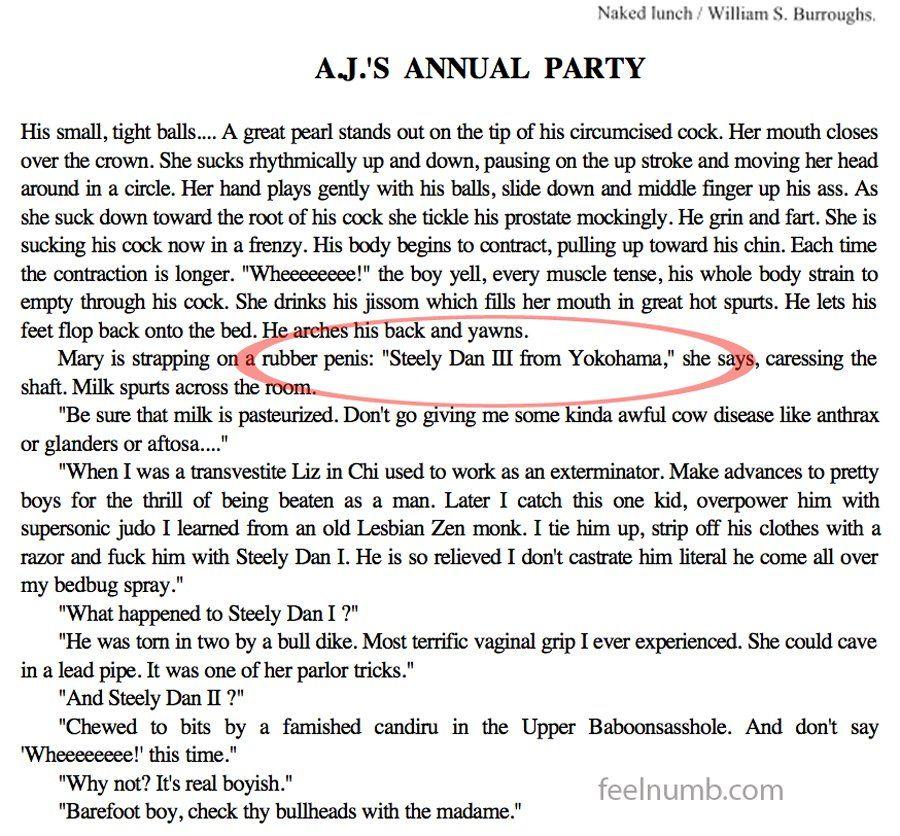Forum Replies Created
-
AuthorPosts
-
March 17, 2020 at 6:17 am #59837
c_howdy
Participant
On Guy Fawkes Night in London in 1997, a financially desperate 16-year-old, Evey Hammond, sexually solicits men who are actually members of the state secret police, called “The Finger”. Preparing to rape and kill her, the Fingermen are dispatched by V, a cloaked anarchist wearing a mask, who later remotely detonates explosives at the Houses of Parliament before bringing Evey to his contraband-filled underground lair, the “Shadow Gallery”. Evey tells V her life story, which reveals her own past as well as England’s recent history. During a dispute over Poland in the late 1980s the Soviet Union and the United States, under the presidency of Ted Kennedy, entered a global nuclear war which left continental Europe and Africa uninhabitable. Although Britain itself was not bombed due to the Labour government’s decision to remove American nuclear missiles, it faced environmental devastation and famine due to the nuclear winter. After a period of lawlessness in which Evey’s mother died, the remaining corporations and fascist groups took over England and form a new totalitarian government, Norsefire. Evey’s father, a former socialist, was arrested by the regime.
-https://en.wikipedia.org/wiki/V_for_Vendetta#Book_1:_Europe_After_the_Reign-
Even a limited India-Pakistan nuclear war would bring global famine, says study
MARCH 16, 2020
by Columbia University
https://phys.org/news/2020-03-regional-nuclear-war-global-food.html
The concept of nuclear winter—a years-long planetary freeze brought on by airborne soot generated by nuclear bombs—has been around for decades. But such speculations have been based largely on back-of-the-envelope calculations involving a total war between Russia and the United States. Now, a new multinational study incorporating the latest models of global climate, crop production and trade examines the possible effects of a less gargantuan but perhaps more likely exchange between two longtime nuclear-armed enemies: India and Pakistan. It suggests that even a limited war between the two would cause unprecedented planet-wide food shortages and probable starvation lasting more than a decade. The study appears this week in the journal Proceedings of the National Academy of Sciences.
Of an estimated 14,000 nuclear warheads worldwide, close to 95 percent belong to the United States and Russia. India and Pakistan are thought to have about 150 each. The study examines the potential effects if they were to each set off 50 Hiroshima-size bombs—less than 1 percent of the estimated world arsenal.
In addition to direct death and destruction, the authors say that firestorms following the bombings would launch some 5 million tons of soot toward the stratosphere. There, it would spread globally and remain, absorbing sunlight and lowering global mean temperatures by about 1.8 degrees C (3.25 F) for at least five years. The scientists project that this would in turn cause production of the world’s four main cereal crops—maize, wheat, soybeans and rice—to plummet an average 11 percent over that period, with tapering effects lasting another five to 10 years.
“Even this regional, limited war would have devastating indirect implications worldwide,” said Jonas Jägermeyr, a postdoctoral scientist at the NASA Goddard Institute for Space Studies who led the study. “It would exceed the largest famine in documented history.”
According to the study, crops would be hardest hit in the northerly breadbasket regions of the United States, Canada, Europe, Russia and China. But paradoxically, southerly regions would suffer much more hunger. That is because many developed nations in the north produce huge surpluses, which are largely exported to nations in the Global South that are barely able to feed themselves. If these surpluses were to dry up, the effects would ripple out through the global trade system. The authors estimate that some 70 largely poor countries with a cumulative population of 1.3 billion people would then see food supplies drop more than 20 percent.
Some adverse effects on crops would come from shifts in precipitation and solar radiation, but the great majority would stem from drops in temperature, according to the study. Crops would suffer most in countries north of 30 degrees simply because temperatures there are lower and growing seasons shorter to begin with. Even modest declines in growing-season warmth could leave crops struggling to mature, and susceptible to deadly cold snaps. As a result, harvests of maize, the world’s main cereal crop, could drop by nearly 20 percent in the United States, and an astonishing 50 percent in Russia. Wheat and soybeans, the second and third most important cereals, would also see steep declines. In southerly latitudes, rice might not suffer as badly, and cooler temperatures might even increase maize harvests in parts of South America and Africa. But this would do little to offset the much larger declines in other regions, according to the study.
Since many developed countries produce surpluses for export, their excess production and reserves might tide them over for at least a few years before shortages set in. But this would come at the expense of countries in the Global South. Developed nations almost certainly would impose export bans in order to protect their own populations, and by year four or five, many nations that today already struggle with malnutrition would see catastrophic drops in food availability. Among those the authors list as the hardest hit: Somalia, Niger, Rwanda, Honduras, Syria, Yemen and Bangladesh.
If nuclear weapons continue to exist, “they can be used with tragic consequences for the world,” said study coauthor Alan Robock, a climatologist at Rutgers University who has long studied the potential effects of nuclear war. “As horrible as the direct effects of nuclear weapons would be, more people could die outside the target areas due to famine.”
Previously, Jägermeyr has studied the potential effects of global warming on agriculture, which most scientists agree will suffer badly. But, he said, a sudden nuclear-caused cooling would hit food systems far worse. And, looking backward, the the effects on food availability would be four times worse than any previously recorded global agriculture upsets caused by droughts, floods, or volcanic eruptions, he said.
The study might be erring on the conservative side. For one, India and Pakistan may well have bombs far bigger than the ones the scientists use in their assumptions. For another, the study leaves India and Pakistan themselves out of the crop analyses, in order to avoid mixing up the direct effects of a war with the indirect ones. That aside, Jägermeyr said that one could reasonably assume that food production in the remnants of the two countries would drop essentially to zero. The scientists also did not factor in the possible effects of radioactive fallout, nor the probability that floating soot would cause the stratosphere to heat up at the same time the surface was cooling. This would in turn cause stratospheric ozone to dissipate, and similar to the effects of now-banned refrigerants, this would admit more ultraviolet rays to the earth’s surface, damaging humans and agriculture even more.
Much attention has been focused recently on North Korea’s nuclear program, and the potential for Iran or other countries to start up their own arsenals. But many experts have long regarded Pakistan and India as the most dangerous players, because of their history of near-continuous conflict over territory and other issues. India tested its first nuclear weapon in 1974, and when Pakistan followed in 1998, the stakes grew. The two countries have already had four full-scale conventional wars, in 1947, 1965, 1971 and 1999, along with many substantial skirmishes in between. Recently, tensions over the disputed region of Kashmir have flared again.
“We’re not saying a nuclear conflict is around the corner. But it is important to understand what could happen,” said Jägermeyr.
The paper was coauthored by a total of 19 scientists from five countries, including three others from Goddard, which is affiliated with Columbia University’s Earth Institute: Michael Puma, Alison Heslin and Cynthia Rosenzweig. Jägermeyr also has affiliations with the University of Chicago and Potsdam Institute for Climate Impact Research.
More information: Jonas Jägermeyr el al., “A regional nuclear conflict would compromise global food security,” PNAS (2020). http://www.pnas.org/cgi/doi/10.1073/pnas.1919049117
Journal information: Proceedings of the National Academy of Sciences
 March 17, 2020 at 5:56 am #59836
March 17, 2020 at 5:56 am #59836c_howdy
ParticipantThe album cover features a photomontage by Robert Lockart. It includes an image of a line of prostitutes, standing in a red light area from Rouen, Normandy (France) waiting for clients, chosen because of its relevance to the album title. The title of the album is taken in reference to the opening line of the Bob Dylan song “It Takes a Lot to Laugh, It Takes a Train to Cry”. Walter Becker and Donald Fagen themselves commented on the album art in their liner notes to the reissued The Royal Scam, saying that that album possessed “the most hideous album cover of the seventies, bar none (excepting perhaps Can’t Buy a Thrill).” The cover was banned in Francisco Franco’s Spain and was replaced with a photograph of the band playing in concert.
-https://en.wikipedia.org/wiki/Can%27t_Buy_a_Thrill-
 March 16, 2020 at 1:32 pm #59835
March 16, 2020 at 1:32 pm #59835c_howdy
Participant…we will die’ without more money…
Small businesses drive China’s economy. The coronavirus outbreak could be fatal for many
Analysis by Laura He, CNN Business
Updated 1433 GMT (2233 HKT)
February 14, 2020
https://edition.cnn.com/2020/02/14/economy/coronavirus-china-economy-small-businesses/index.html
Hong Kong (CNN Business)The small companies that drive China’s economy are worried about how much damage the novel coronavirus outbreak will cause. Without help or a reprieve from the disease, many may have only weeks to survive.
While some larger companies are reopening their doors after weeks of lockdowns designed to contain the epidemic, small businesses often can’t comply with the strict health rules now required in many regions and many don’t have the option of letting employees work from home.
A survey of 163 companies of all sizes across China found that less than half were able to get back to work this week, according to investment bank China International Capital Corp, which published the results. Even more alarming: A third of roughly 1,000 small and medium-sized companies surveyed by academics from Tsinghua University and Peking University last week said they could only survive for a month with the cash they have.
That could spell terrible news for China’s entrepreneurs — and an even worse reality for the country’s economy. About 30 million small and medium-sized businesses contribute more than 60% of the country’s GDP, according to government statistics published last September. The taxes they pay account for more than half of government revenue, and they employ more than 80% of China’s workers.It’s not clear how many of those companies will ultimately feel the full impact of the virus. Surveys cover only a tiny slice of the sector, and the full extent of the outbreak’s consequences are still impossible to determine. But many small companies were already struggling before the coronavirus began infecting tens of thousands across the country. The world’s second largest economy has been slowing down due to a combination of rising debt, a slump in domestic demand and a trade war with the United States. Now they face going without business for weeks on end.
“The coronavirus could be the straw that breaks the camel’s back,” wrote Zhao Jian, director of the Shandong province-based Atlantis Research Institute in a research note earlier this month. He warned that if the outbreak doesn’t end soon, unemployment will likely rise as businesses shut down — a problem Beijing had been fighting hard this year to prevent. Job losses could spur a tide of housing foreclosures, Zhao added, compounding the country’s economic woes.Some business owners have gone public with their plight. Beijing entrepreneur Wu Hai wrote on social media app WeChat this week that the outbreak could destroy more than 50 karaoke bars he runs across the country. The pastime has been halted as the government maintains a shutdown of popular entertainment spots where “cross infection risks” are high.
In the post, Wu lamented the closures and said the lack of business puts his 1,500 workers at risk of losing their jobs. He wrote that his company, MeiKTV, has about 12 million yuan ($1.7 million) in cash on hand, giving it about two months to survive if he’s unable to reopen for business.
“That means we will die in April unless investors continue to give us money,” he wrote.Shu Congxuan, chairman of Home Original Chicken, said last Saturday that his fast food chain has shut more than 400 stores since the outbreak began. In a Weibo post, he warned that his company is in danger of running out of cash, since it still needs to pay rent and employees. But he said he would try to make sure his employees keep their jobs, even if he needs to sell his houses and cars.
Other companies appear to be taking desperate measures to recoup at least some of their losses. Beijing-based Meizhou Dongpo Restaurant said on Weibo that its employees have set up stalls to sell fresh vegetables on the street. While the company did not elaborate on the reason for its decision, a local government-run newspaper reported that the restaurant had purchased fresh produce for the Lunar New Year holiday season, but was unable to use it because of the outbreak.
The outcome for many businesses could be dire if the situation does not improve rapidly. According to the Tsinghua University and Peking University survey of firms, 85% of respondents said they would go out of business if the outbreak lasts three months. By the six month mark, 90% of the companies would collapse.Even a recovery in the near future may not come soon enough for some. Before the outbreak, Chinese companies were preparing to pay back or refinance a lot of debt this year, according to analysts at S&P Global Ratings. Given the rising risk to the economy, they may find it harder to borrow.
The S&P researchers warned in a note this week that if the public health crisis stabilizes next month, liquidity will still be under pressure through at least the first half of the year. They added that the outbreak will also heighten the risk of default for Chinese companies.Beijing already knows that it has a major problem on its hands. Before the outbreak, senior officials had characterized the prevention of mass unemployment as their top priority for 2020. Now that the likelihood of mass job losses is increasing, the country is going all out to stop it from happening.
Some of the most prominent companies in China, for example, are taking in workers displaced by the outbreak. JD.com (JD), one of China’s largest e-commerce firms, earlier this week promised to open up more than 20,000 new positions. Alibaba (BABA) announced a similar plan.
The government is also stepping in. Last week, the People’s Bank of China pumped billions of dollars into the money market to shore up banks’ ability to lend money. The central bank also set up a 300 billion yuan ($43 billion) special fund to provide cheap loans to key companies in epidemic prevention. Meanwhile, the finance ministry announced government subsidies to make those loans even cheaper.Local governments in Beijing, Shanghai and several provinces have also rolled out targeted measures to help small businesses, including offering subsidies to landlords so they can reduce rents, and allowing small companies to delay the payment of social security contributions or taxes.
But it’s not clear how helpful some of those policies will be.
Wu, the karaoke bar owner, wrote in his WeChat post that he felt his company was still at a “dead end” even with the policies offered to him. Social security, for example, is still a major expense for employers. Wu suggested that simply delaying those payments would not really help.
“Social Security Bureau, how generous you are,” Wu commented sarcastically. “Our employees are going to lose jobs. The company is going to collapse. You not only don’t want to take some money out, but you still want to collect money from us — not even a penny less!”
Wu did not respond to a request for comment from CNN Business. But in his WeChat post he also criticized the usefulness of giving subsidies to landlords. While he said the policy is “well intended,” he questioned whether landlords would actually reduce the amount their tenants pay.
He also doubted the effectiveness of preferential loans set up by the central bank.
“We have no fixed assets as collateral. We have no operating cash flows — because we can’t open for business — as collateral,” Wu wrote. “Tell me, which small and medium-sized company can get the bank funding?”
 March 16, 2020 at 1:01 pm #59834
March 16, 2020 at 1:01 pm #59834c_howdy
Participant
…we recognize that social isolation for millions of Californians is anxiety-inducing, but … we need to meet this moment head-on and lean in,” Newsom said…
Coronavirus forces radical changes to California with sweeping restrictions on life
By PHIL WILLON, ALEX WIGGLESWORTH, TARYN LUNA, LAURA NEWBERRY
MARCH 16, 20208:59 AM
SACRAMENTO — In a sweeping effort to slow the spread of coronavirus in California, Gov. Gavin Newsom on Sunday urged people 65 and older and those with chronic health conditions to isolate themselves from others — a directive that reflects the fast-moving nature of a public health crisis that threatens the well-being of some 40 million Californians.
Hours later, Mayor Eric Garcetti said Los Angeles bars and nightclubs will close and restaurants must halt dine-in service and limit their business to takeout orders until March 31. The order became effective at midnight Sunday.
Movie theaters, gyms and fitness centers also will be closed, Garcetti said in a video news conference Sunday. Grocery stores, pharmacies and food banks will remain open. And Garcetti announced a moratorium on evictions for renters.
As businesses across Los Angeles took action, more than 50,000 of the city’s government employees are still being asked to go to work.
City employees can’t refuse to go to work out of fear that they’ll be infected with the virus, Wendy Macy, general manager of the city’s personnel department, wrote in a memo to department heads Friday. Telecommuting options are available for some employees and some exceptions are allowed, according to emergency guidelines issued by the city’s personnel department.
Newsom also called on bars and brewery and winery tasting rooms statewide to close their doors to patrons as the number of confirmed coronavirus cases in the state continued to rise.
“We recognize that social isolation for millions of Californians is anxiety-inducing, but … we need to meet this moment head-on and lean in,” Newsom said.
But Newsom again stopped short of using the full force of his authority to mandate response measures to protect Californians from the virus that causes COVID-19, a global pandemic that has resulted in six deaths and 335 confirmed cases in the state.
Instead, the governor said his request of bars and pubs is akin to an announcement he made last week asking for the cancellation of gatherings of 250 people or more. The governor is allowing restaurants to remain open and advised customers to practice “deep social distancing” when dining out — in effect, a recommendation to reduce occupancy by half.
The Centers for Disease Control and Prevention has introduced even more stringent recommendations, suggesting that events of 50 people or more should be suspended for about two months. When feasible, organizers could modify events to be virtual, but in-person events of that size should be canceled or postponed, the agency said Sunday.
The efforts come as more coronavirus cases were reported, including a positive test for a police officer at Los Angeles International Airport. Los Angeles County reported 16 new cases Sunday, bringing the county’s total to 69.
A USC student who had recently returned from international travel but has not been on or near the USC campuses — also tested positive for coronavirus, the university said Sunday. The student was reportedly in good condition and self-isolating at home.
San Luis Obispo, Santa Barbara and San Bernardino counties recorded their first cases of the virus over the weekend. Santa Clara County, which has been the hardest-hit county in the state, announced 23 more cases for a total of 114.
Of California’s confirmed cases, 70 are believed to be from community transmission, the state Department of Public Health said. The rest are a mix of confirmed person-to-person transmissions related to travel or patients returning to the country after contracting the disease elsewhere.
Newsom’s guidelines follow other broad efforts announced in recent days to combat the virus in California. Most of those have been taken on the local level, including the decision by dozens of school districts to shut down for the next two weeks or longer.
The governor said he would issue additional directives on Tuesday to schools that remain open and said he was especially focused on providing support to low-income families.
He suggested some local school officials had not fully thought through the consequences when closing their campuses, including how to continue providing meals to students eligible for free or reduced-price lunches and how to ensure that students with special needs receive adequate care and supervision.The virus also has disrupted college entrance exams. The company that administers the ACT announced Monday that it has moved its testing date from April 4 to June 13 in response to concerns over the pandemic.
“ACT is committed to making every effort to help those students impacted by this test date change, particularly those high school seniors who are facing deadlines for fall 2020 college admission,” ACT Chief Executive Officer Marten Roorda said in a statement.
Newsom estimated that his directive to seniors would affect 5.3 million Californians. While that number includes those most at risk simply due to their age, he said it does not include the millions more who have underlying health conditions that would make them vulnerable.
The governor’s office said his request for seniors to remain at home also extended to residents with underlying health issues, such as chronic kidney disease, asthma, chronic liver disease, pregnancies in the last two weeks, metabolic disorders, heart disease and other conditions that make them more susceptible to serious illness from the coronavirus.
In a statement, Garcetti commended Newsom’s guidance.
“Everything we do right now will determine the outcome of this crisis, and we can save lives if we stay calm, care for one another, and take forceful steps to protect our communities,” Garcetti said. “That’s why we must follow the guidelines laid out by Gov. Newsom, build on them for local needs, and put the health and safety of the most vulnerable above all else.”
The governor also announced that the state’s 108,000 homeless people would be the top priority for mitigation policies, with a significant push to move them indoors.
Though details remained unclear, he said the state had hotels and motels that could be used to provide shelter, along with an additional 450 state-owned trailers sent to “critical points” to supplement those that were deployed in Los Angeles, Stockton, Sonoma and other places before the outbreak.Last week, Newsom issued an executive order allowing the state to commandeer some private properties to provide beds for isolation. Newsom said the goal of the newly announced measures aimed at the unsheltered population was to “get people into environments where we can address their growing anxiety and our growing concerns.”
He stopped short, however, of saying the attempt to bring people indoors would be mandated or require law enforcement intervention.
In recent days, the Department of Housing and Urban Development and the CDC have also detailed guidelines for homeless shelters and encampments, many of which include increasing sanitation and providing detailed suggestions for handling ill people in shelter settings.
“I am not ratcheting up a mind-set of enforcement,” Newsom said.
Sacramento mayor Darrell Steinberg, co-head of Newsom‘s statewide task force on homelessness, said Newsom‘s move to bring homeless people inside was crucial.
“They are very susceptible to disease and infection,“ said Steinberg of unsheltered populations. Leaving them outdoors, he said, is “really an invitation for a more wide spread of the disease.
Randy Simonsen, a 65-year-old homeless man in Sacramento, said that he would like to go indoors during this crisis. He listened to the governor’s speech on a transistor radio and heard the call for older residents to stay home. But “I don’t have one,” Simonsen said.
In L.A. County, Dockweiler State Beach may be used to temporarily house people who have been ordered to isolate or quarantine because of the coronavirus. The beach’s RV park on Vista del Mar is one of several locations the county could use for that purpose, according to a news release from the City of El Segundo. Officials said the public should avoid the area.
Anxious Californians continued to clear the shelves of local grocery stores. The Los Angeles Police Department assured residents on Twitter that there is no food shortage and stores will restock.
“The water supply is clean & safe to drink, so there’s no need to buy water in bulk,” the department said.
Grocery chains have announced changes to deal with the relentless throngs of shoppers.
Ralphs, for example, said it is working with suppliers to replenish high-demand products, and its store hours have been curtailed so employees have more time to restock. Albertsons — which operates the grocery chains Vons, Pavilions and Safeway — said it is taking similar steps.
Starbucks announced new efforts to limit the number of people gathering at its coffeehouses. All of its stores in the U.S. and Canada will move to a “to go” model for at least two weeks and will remove all seating in cafe and patio areas, the company announced Sunday.
As airports across the country were thrown into chaos this weekend because of hastily rolled-out health screenings for travelers returning from Europe, LAX remained relatively calm. But average wait times were still about 30 minutes longer than usual, said LAX spokesman Heath Montgomery.
Though many businesses have been affected by a slower streams of customers, bars in West Hollywood were packed on Sunday afternoon.
At Rocco’s WeHo and Flaming Saddles, drag queens danced to deafening music as they were cheered on by crowds handing them dollar bills on the stage. In these places, at least, life seemed to go on as normal.
Not everyone was proceeding with business as usual. At the Abbey, West Hollywood’s most popular gay bar, the gates were closed. On each door, a sign read: “As we continue to navigate the rapidly changing conditions with COVID 19, the Abbey is closing temporarily. We plan to open as soon as our public health officials tell us it is safe.”
Jimmy Han, who owns Frank ‘n Hank bar in Koreatown, said he decided to close his bar down Saturday after seeing customers not follow the 6-foot social distancing rule he tried to implement.
“I’ll be losing a lot of money and so will my employees, but honestly, that’s the least of our concern right now,” he said. “We’re more worried about public health and how this is going to impact the economy long term.”
Times staff writers Suhauna Hussain, Alejandra Reyes-Velarde, John Myers, Anita Chabria, Benjamin Oreskes and Hannah Fry contributed to this report.
March 16, 2020 at 12:40 pm #59833c_howdy
ParticipantMost airlines face bankruptcy by end of May, industry body warns
FT Reporters
5 HOURS AGO
https://www.ft.com/content/30a3a26e-674f-11ea-800d-da70cff6e4d3
The airline industry is warning that it must shed jobs and obtain state support to survive the coronavirus crisis, as carriers around the globe grounded the majority of their fleets and took steps to conserve cash.
In the past 24 hours, United Airlines of the US, IAG — parent of British Airways, Aer Lingus and Iberia — Air France-KLM, easyJet, Finnair, Air New Zealand and Aeroflot all unveiled drastic measures to cut costs after several countries, including Germany and Spain, closed their borders.
Willie Walsh, head of IAG, will postpone his retirement to steer the group through the health emergency. Announcing a 75 per cent reduction in capacity over the next two months, Mr Walsh said there was no guarantee that many European airlines would survive.
“The situation is going to be quite dynamic in the next few weeks,” he said. “There are many airlines out there who are severely stressed with little or no cash resources.” There was no guarantee that many European airlines would survive, he said.
His comments came as the Centre for Aviation, a respected aviation consultancy, warned that by the end of May most airlines would be bankrupt due to the unprecedented travel restrictions that are being rolled out by governments around the world.
“Many airlines have probably already been driven into technical bankruptcy, or are at least substantially in breach of debt covenants,” Capa said in a report. “By the end of May 2020, most airlines in the world will be bankrupt. Co-ordinated government and industry action is needed — now — if catastrophe is to be avoided.”
Iata, the industry trade body, estimated that the industry would lose up to $113bn in revenue as a result of the crisis. But that was before the widening international lockdown. The three global airline alliances, Oneworld, SkyTeam and Star Alliance — which represent close to 60 carriers accounting for half the world’s capacity — called on governments, airports, lessors and other stakeholders to help the industry.
Mr Walsh said his group had not asked for state aid. He stressed that the group had total liquidity of €9.3bn and was taking actions to cut costs and preserve cash, such as grounding surplus aircraft, reducing and deferring capital spending and cutting working hours.
Ryanair, Europe’s biggest low-cost carrier, raised the prospect that all of its aircraft could be grounded in the coming months as it joined the ranks of other airlines racing to cut costs and preserve cash in the wake of Europe’s widening border lockdowns. Michael O’Leary, chief executive, said capacity would be reduced by 80 per cent in April and May but “a full grounding of the fleet cannot be ruled out”.
In those countries where the fleet was not grounded, “social distancing restrictions may make flying to all intents and purposes, impractical, if not, impossible”, he said.
Air France-KLM said it would be reducing capacity by 70-90 per cent and had a “sharply deteriorated financial trajectory”. It said it welcomed statements from the French and Dutch governments that they were studying all possible means to support the group. It said a host of emergency measures — ranging from cost savings of up to €200m and plans to cut employee hours — would only offset the capacity reduction by half.
United Airlines in the US and Air New Zealand have told staff that they will begin redundancy processes, as travel restrictions force carriers to slash capacity and ground tens of thousands of aircraft.
Air New Zealand said on Monday that it would reduce international capacity by 85 per cent and cut domestic capacity by almost a third in April and May. The carrier, which employs 8,000 people, said it would consult with trade unions about redundancies.
That followed news from United that it is planning to halve its capacity for April and May, and has warned its nearly 100,000 employees of “painful” cuts to its payroll.
US carriers United, American Airlines and Delta Air Lines have all announced deep cuts to their international services and have begun talking to the federal government about possible assistance.
EasyJet, Europe’s second biggest low-cost carrier, withdrew its guidance for this year and said it was cutting capacity, although it did not quantify the reduction. Like many carriers it is in discussions with financiers to bolster its liquidity position. It said it had cash balances of £1.6bn and an undrawn $500m revolving credit.
Finnair is cutting 90 per cent of its capacity and its dividend amid what the Finnish flag carrier described as the “biggest crisis in the history of aviation” thanks to the coronavirus outbreak. The Finnish airline warned of a substantial financial loss this year and was working urgently on a funding plan including credit lines, loans, and the sale and leaseback of aircraft. Finland’s government, which owns more than half of the shares “will actively support” Finnair, the airline said.
Aeroflot, the Russian airline, also announced that it was suspending flights to several international destinations.
Airlines for Australia and New Zealand, an industry group representing carriers in both countries, said the airline sector was seeking state support including relief on government charges and possible grants that could be made available from government stimulus packages.
Alison Roberts, chief executive of the industry group, said carriers faced a situation that was much more serious than the global financial crisis in 2008.
S&P underscored the perilous state of the industry on Monday by downgrading its credit rating on Australia’s second-largest carrier, Virgin Australia, to B- from B+. The credit rating agency warned that the operating environment “may be deteriorating at a faster pace than Virgin can implement initiatives to protect cash generation and balance sheet health”.
Australia’s Transport Workers’ Union wrote to Australia’s prime minister, Scott Morrison, on Monday urging the government to subsidise airlines and aviation companies, warning that large scale lay-offs or business collapses would hamper economic recovery.
“When the current crisis comes to an end, the Australian economy will need a healthy transport industry in place,” said Michael Kaine, TWU national secretary, in a letter to Mr Morrison seen by the Financial Times.
Reporting by Jamie Smyth in Sydney, Andrew Edgecliffe-Johnson in New York, Peggy Hollinger and Myles McCormick in London, David Keohane in Paris, and Richard Milne in Oslo
Copyright The Financial Times Limited 2020. All rights reserved

Coronavirus
March 12, 2020 at 8:57 pm #59826c_howdy
Participant

MARCH 12, 2020
Protective brain-cell housekeeping mechanism may also regulate sleep
by Perelman School of Medicine at the University of Pennsylvania
https://medicalxpress.com/news/2020-03-brain-cell-housekeeping-mechanism.html
An important biological mechanism that is thought to protect brain cells from neurodegenerative diseases such as Alzheimer’s and Parkinson’s may also be involved in regulating sleep, according to new research from the Perelman School of Medicine at the University of Pennsylvania. The researchers found that a signaling pathway that helps prevent the buildup of abnormal protein aggregates in brain cells is also required for sleep in both fruit flies and zebrafish. The fact that this mechanism is present in two evolutionarily distant species suggests that it may also be present in humans.
There have long been puzzling hints that sleep loss and sleep disorders are connected to neurodegenerative diseases, and the findings, published online today in Current Biology, reveal one possible explanation for the link. If the results were extended to humans, they would point the way to new strategies against both sleep disorders and neurodegenerative diseases.
“Sleep fragmentation, which is characterized by repetitive short sleep interruptions, is one of the most common triggers of excessive daytime tiredness, especially in older people,” said principal investigator Nirinjini Naidoo, Ph.D., a research associate professor of Sleep and Chronobiology. “Now that we know a major pathway that is involved in sleep regulation, we can target it to potentially improve fragmented sleep.”
Studies in recent years have suggested that chronic sleep loss increases the risk of Alzheimer’s, while people with Alzheimer’s have an elevated risk of sleep disturbances. Sleep disturbances are also common features of Parkinson’s disease, amyotrophic lateral sclerosis (ALS), frontotemporal dementia, and other neurodegenerative diseases.
How the processes underlying neurodegenerative disease might be connected to sleep disturbances has never been clear. But one hint comes from findings in lab animals that the brain during sleep dials up “proteostasis” processes that clear away abnormal and potentially harmful protein aggregates, such as those that clutter the brain in neurodegenerative disorders.
In the new study, Naidoo and her colleagues scrutinized an important proteostasis process called the PERK signaling pathway, which, in response to a buildup of unwanted protein aggregates, causes cells temporarily to stop their assembly of most proteins. The scientists found that when they suppressed PERK signaling in Drosophila fruit flies or in evolutionarily distant zebrafish, using small-molecule compounds that block a key component of the pathway, both sets of animals slept much less than normal. Blocking PERK with genetic techniques in Drosophila brought similar results, while doing the reverse—forcing the overproduction of PERK—made the flies sleep more.
Ph.D. candidate Sarah Ly examined tiny groups of neurons that produce a key wakefulness-promoting hormone in Drosophila, and found that knocking down PERK at night, just in these neurons, was enough to make the flies sleep less, whereas overproducing PERK made them sleep more. In one subset of these neurons the researchers were able to verify that boosting or reducing PERK had the effect of suppressing or unleashing production of the wakefulness hormone. “This raises possibility that PERK regulation of sleep occurs within multiple brain circuits,” Ly said.
This discovery marks the first time that scientists have identified a specific and bidirectional biological mechanism tying sleep to proteostasis. The findings also point to the possibility that wakefulness tends to increase protein-aggregate accumulation in brain cells, leading to more PERK signaling. This ultimately helps reverse the brain-cell stress by enforcing sleep and allowing effective protein housekeeping to take place.
“Our findings suggest that one of the conserved functions of sleep may be to mitigate cellular stress caused by wakefulness,” said Naidoo.
The authors believe that further research into this nexus between sleep and proteostasis has the potential to uncover important new therapeutic strategies for improving sleep quality, reducing the risk of Alzheimer’s and other neurodegenerative diseases, and effectively slowing the aging of the brain.
More information: Sarah Ly et al, Evolutionarily Conserved Regulation of Sleep by the Protein Translational Regulator PERK, Current Biology (2020). DOI: 10.1016/j.cub.2020.02.030
Journal information: Current Biology
 March 12, 2020 at 8:48 pm #59825
March 12, 2020 at 8:48 pm #59825c_howdy
ParticipantK. Sad & depressed => F. Dreamy => M. Triumphant & heroic (human emotional spectrum above)
Finnish lyrics tell about person who is so poor temporarily that there isn’t any money even for a modest meal, but she then decides to start to bottle her tears and sell them.
Sorry for my broken English.
HOWDY
 March 12, 2020 at 2:20 pm #59823
March 12, 2020 at 2:20 pm #59823c_howdy
ParticipantRobin Maconie finds that, “Compared to the work of his contemporaries, Stockhausen’s music has a depth and rational integrity that is quite outstanding… His researches, initially guided by Meyer-Eppler, have a coherence unlike any other composer then or since” (Maconie 1989, 177–78). Maconie also compares Stockhausen to Beethoven: “If a genius is someone whose ideas survive all attempts at explanation, then by that definition Stockhausen is the nearest thing to Beethoven this century has produced. Reason? His music lasts” (Maconie 1988), and “As Stravinsky said, one never thinks of Beethoven as a superb orchestrator because the quality of invention transcends mere craftsmanship. It is the same with Stockhausen: the intensity of imagination gives rise to musical impressions of an elemental and seemingly unfathomable beauty, arising from necessity rather than conscious design” (Maconie 1989, 178).
-https://en.wikipedia.org/wiki/Karlheinz_Stockhausen#Criticism-
Stockhausen regarded Kreuzspiel as his first original composition, as opposed to the style-imitation exercises he did as part of his music studies (Stockhausen 1989, 34, 55). According to the composer, it was influenced by Olivier Messiaen’s “Mode de valeurs et d’intensités” (1949) and Karel Goeyvaerts’s Sonata for Two Pianos (1950), and is one of the earliest examples of “point” music. Kreuzspiel was premièred at the Darmstädter Internationale Ferienkurse in the summer of 1952, conducted by the composer. According to Stockhausen, the performance “ended in a scandal” (Stockhausen 1964, 11)
-https://en.wikipedia.org/wiki/Kreuzspiel-

 March 12, 2020 at 10:58 am #59822
March 12, 2020 at 10:58 am #59822c_howdy
Participant
MARCH 12, 2020
Building blocks for life on Earth arrived much later than we thought, billion-year-old rocks show
by University of New South Wales
https://phys.org/news/2020-03-blocks-life-earth-thought-billion-year-old.html
Ancient rocks from Greenland have shown that the elements necessary for the evolution of life did not come to Earth until very late in the planet’s formation—much later than previously thought.
An international team of geologists—led by the University of Cologne and involving UNSW scientists—have published important new findings about the origin of oceans and life on Earth: they have found evidence that a large proportion of the elements that are essential to the formation of oceans and life—such as water, carbon and nitrogen—only came to Earth very late in its history.
Many scientists previously believed that these elements had already been there at the beginning of our planet’s formation. However, the geological investigations published in Nature today have shown that most of the water in fact only came to Earth when its formation was almost complete.
Volatile elements such as water originate from asteroids, the planetary building blocks that formed in the outer solar system. There has been a lot of discussion and controversy in the scientific community around when precisely these building blocks came to Earth.
Dr. Mario Fischer-Gödde from the Institute of Geology and Mineralogy at the University of Cologne, who led the work, says we are now able to narrow down the timeframe more precisely.
“The rocks we analyzed are the oldest preserved mantle rocks. They allow us to see into the early history of the Earth as if through a window.
“We compared the composition of the oldest, approximately 3.8 billion-year-old, mantle rocks from the Archean Eon with the composition of the asteroids from which they formed, and with the composition of the Earth’s mantle today.”
To understand the temporal process, the researchers determined the isotope abundances of a very rare platinum metal called ruthenium, which the Archean mantle of the Earth contained.
Like a genetic fingerprint, the rare platinum metal is an indicator for the late growth phase of the Earth.
“Platinum metals like ruthenium have an extremely high tendency to combine with iron. Therefore, when the Earth formed, ruthenium must have been completely discharged into the Earth’s metallic core,” says Professor Fischer-Gödde.
Professor Martin Van Kranendonk, the UNSW scientist who was part of the research, says the reason why this is of such interest relates directly to understanding the origins of life on Earth, how we humans came to be, and in fact, to whether we might be alone, or have neighbours in the universe.
“This is because the results show that Earth did not really become a habitable planet until relatively late in its accretionary history,” he says.
“If you combine this with the evidence for very ancient life on Earth, it reveals that life got started on our planet surprisingly quickly, within only a few hundred million years. Now this might sound like a lot of time, and it is, but it is far different from what we used to think, that life took half a billion, or even a billion years to get started.
“And this gives hope for finding life on other planets that had a shorter geological history and period of ‘warm and wet’ conditions than Earth, because if life could get started quickly here, then perhaps it got started quickly elsewhere.”
Professor Dr. Carsten Münker, also at the University of Cologne, added: “The fact that we are still finding traces of rare platinum metals in the Earth’s mantle means that we can assume they were only added after the formation of the core was completed—they were certainly the result of later collisions of the Earth with asteroids or smaller planetesimals.”
Scientists refer to the very late building blocks of Earth, which arrived through these collisions, as the ‘late veneer.”
“Our findings suggest that water and other volatile elements such as carbon and nitrogen did indeed arrive on Earth very late in the ‘late veneer’ phase,” Professor Fischer-Gödde says.
The new findings are the result of collaboration among scientists from Germany, Denmark, England, Australia and Japan. The scientists are planning further field trips to India, northwestern Australia, and Greenland to investigate more rock samples.
More information: Mario Fischer-Gödde et al. Ruthenium isotope vestige of Earth’s pre-late-veneer mantle preserved in Archaean rocks, Nature (2020). DOI: 10.1038/s41586-020-2069-3
Journal information: Nature
March 12, 2020 at 9:12 am #59821c_howdy
ParticipantTsuigiri literally means ‘crossroads killing’ and is the Japanese term for a very dishonourable practice whereby someone who has received a new weapon or developed a new fighting style or weapon tests its effectiveness by attacking an innocent opponent. For Karl and Shaun this was a very important part of training. In the early days they would visit pubs and wait for groups of aggressive lads to cause problems, but anyone posturing would be a potential challenge. If a gang of skinheads or bikers was seen, they would immediately get excited. What group of thugs would turn down a fight with two or three men?
-MARTIN FAULKS Becoming a Ninja Warrior-
 March 12, 2020 at 4:23 am #59819
March 12, 2020 at 4:23 am #59819c_howdy
Participant
English-speakers have only recently applied this German word to a paranormal concept. Francis Grose’s, Provincial Glossary of 1787 used the term fetch instead, defined as the “apparition of a person living.” Catherine Crowe’s book on paranormal phenomena, The Night-Side of Nature (1848) helped make the German word well-known. However, the concept of alter egos and double spirits has appeared in the folklore, myths, religious concepts, and traditions of many cultures throughout human history.In Ancient Egyptian mythology, a ka was a tangible “spirit double” having the same memories and feelings as the person to whom the counterpart belongs. The Greek Princess presents an Egyptian view of the Trojan War in which a ka of Helen misleads Paris, helping to stop the war.[citation needed]. This is depicted in Euripides’ play Helen. In Norse mythology, a vardøger is a ghostly double who is seen performing the person’s actions in advance. In Finnish mythology, this is called having an etiäinen, “a firstcomer”. The doppelgänger is a version of the Ankou, a personification of death, in Breton, Cornish, and Norman folklore.
-https://en.wikipedia.org/wiki/Doppelg%C3%A4nger#Mythology-
According to the Takenouchi Keisho Kogo Den, the document recording the establishment and development of the school, Takenouchi Hisamori retired to the mountains near the Sannomiya shrine to train his martial skills. He practiced there for six days and six nights, wielding a bokken (wooden sword) two shaku and four sun in length (about 2 ft. 4 in. or 72 cm), a relatively long weapon for his purportedly short stature. On the sixth night he fell asleep from exhaustion using his bokken as a pillow. He was woken by a mountain priest with white hair and a long beard who seemed so fearsome to Hisamori that he thought it must be an incarnation of the god Atago. Hisamori attacked the stranger, but was defeated. The priest said to him “When you meet the enemy, in that instant, life and death are decided. That is what is called hyōhō (military strategy).” He then took Hisamori’s bokken, told him that long weapons were not useful in combat, and broke it into two daggers one shaku and two sun long. The priest told Hisamori to put these in his belt and call them kogusoku, and taught him how to use them in grappling and close combat. These techniques became called koshi no mawari, literally “around the hips”. The priest then taught Hisamori how to bind and restrain enemies with rope, using a vine from a tree. Then the priest disappeared mysteriously amidst wind and lightning.
-https://en.wikipedia.org/wiki/Takenouchi-ry%C5%AB#History-
-https://www.amazon.com/Ring-Book-1-Koji-Suzuki/dp/1932234411/-
 March 9, 2020 at 10:26 pm #59813
March 9, 2020 at 10:26 pm #59813c_howdy
ParticipantSteely Dan, a group famous for such hits as “Rikki Don’t Lose That Number,” “Do It Again,” and “Hey Nineteen,” was founded by Becker and Fagen. Although the duo played with many other musicians over the years, they remained the core.
So who is Steely Dan? “Steely Dan III from Yokohama” is the name of an oversized steam-powered strap-on dildo mentioned in William S. Burroughs’s psychotropic textgasm Naked Lunch.
-https://theweek.com/articles/722727/11-band-names-that-dont-mean-what-think-
Ps. HOG=harley owner’s group
 March 9, 2020 at 8:39 pm #59812
March 9, 2020 at 8:39 pm #59812c_howdy
ParticipantDON HENLEY (about One of These Nights): We like to call it our “satanic country-rock period”.
-https://en.wikipedia.org/wiki/The_Very_Best_Of_(Eagles_album)-

 March 9, 2020 at 6:22 pm #59811
March 9, 2020 at 6:22 pm #59811c_howdy
ParticipantThe Altamont Speedway Free Festival was a counterculture rock concert held on Saturday, December 6, 1969 at the Altamont Speedway, northern California, United States. Approximately 300,000 attended the concert, and some anticipated that it would be a “Woodstock West”. Woodstock was held in Bethel, New York, in mid-August, less than four months earlier. The event is best known for considerable violence, including the stabbing death of Meredith Hunter and three accidental deaths: two caused by a hit-and-run car accident, and one by LSD-induced drowning in an irrigation canal. Scores were injured, numerous cars were stolen and then abandoned, and there was extensive property damage.
-https://en.wikipedia.org/wiki/Altamont_Free_Concert-
 March 9, 2020 at 6:11 pm #59810
March 9, 2020 at 6:11 pm #59810c_howdy
ParticipantWith Satan’s hog no pig at all
And the weather’s getting dry
We’ll head south from Altamont
In a cold-blood traveled trance
So clear the road, my bully boys
And let some thunder pass
We’re pain, we’re steel, a plot of knives
We’re Transmaniacon–MC
Behind the pantry, behind the tree
The ghouls adopt that child
Whose name resound forever
Whose name resounds in terror
And I’m no fool to call that hog
‘Cause, man, I remember
Those who did resign their souls
To Transmaniacon–MC
And surely we did offer up
Behind that stage at dawn
Beers and barracuda
Reds and monocaine, yeah
Pure nectar of antipathy
Behind that stage at dawn
To those who would resign their souls
To Transmaniacon–MC
Cry the cable, cry the word
Unknown terror’s here
And won’t you try this tasty snack
Behind the scene or but the back
Which was the stage at Altamont
My humble boys of listless power
We’re pain, we’re steel, a plot of knives
We’re TransmaniaconLook, all right! You can feel it!


-
AuthorPosts
